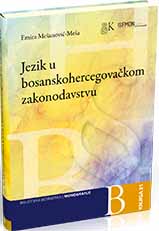Jezik u bosanskohercegovačkom zakonodavstvu
Language of the Bosnian-Herzegovinian legislation
Author(s): Emira Mešanović-Meša
Subject(s): Morphology, Lexis, South Slavic Languages
Published by: Slavistički komitet BiH
Keywords: Bosnian language; legislation; lexeme; morphology;
Summary/Abstract: Bosnia and Herzegovina is one of the countries that officially use more than one language, and therefore, as many as three languages have been declared official – Bosnian, Croatian, Serbian. These languages are so related and similar to one another that communication among their users goes on quite smoothly, but for the official purposes, numerous documents undergo the process of adaptation to each of these three languages . Thus,legislative and legal documents are published, i.e. laws, decrees, resolutions, rules, regulations, statutes, etc., and each of these documents has three language versions: Bosnian, Croatian, and Serbian. The subject of this study is a linguistic analysis of legislative and legal documents in Bosnia and Herzegovina and it identifies phonetic, morphological, syntactic, and lexical features of these texts, compared to the standard language norms of the Bosnian, Croatian and Serbian language. At the phonetic level, we ob-served the following phenomena: the alternation of vowels a/o, a/u, a/e, o/u,and fleeting a, ablaut, reflex of jat, jotations, reduction of consonants, consonant ellision and other alternations (the adaptation of sounds in words of foreign origin), the phoeneme h, umlaut and vowel shift. Since nouns dominate in these texts (the administrative style is nominal by its grammatical nature), they deserve the most attention on the morphological and formational level, followed by adjectives, pronouns, numbers, verbs, adverbs, and particles. At the level of the syntactic analysis, the competition between the infinitive complement and the present complement with the conjunction da in a complex verbal predicate has emerged as an interesting phenomenon, in addition to the well-known competing of the congruent and the in-congruent attribute, as well as the prepositionless genitive and the accusative with a preposition in the form of an incongruent attribute with certain lexemes. The use of temporal and causal adverbs characterized the analysis of adverbials. After having done the phonetic, morphological, and syntactic analysis, the isolated linguistic phenomena were harmonized with all three norms, but also with each language separately. Most norm violations were detected in the texts in the Croatian language, whereas in the texts in the Bosnian and the Serbian language, we observed some phenomena that are designated as specific features of texts in these languages. Finally, the use of certain lexemes related to the legal profession was observed within the lexical analysis. Results of this study indicate that, although it contradicts the normative principles of a language, we find the examples of equal use of both forms (structures) or equal use of both lexemes, whereas, on the other hand, differences between the language norms are made even in places where there is no normative justification for that. Therefore, it was pointed out how this way of adapting the documents to three language standards does not provide a true picture of the language features and norms, and the differences between texts and languages become artificial and unnecessary.
- Print-ISBN-13: 978-9958-648-24-3
- Page Count: 342
- Publication Year: 2019
- Language: Bosnian
- eBook-PDF
- Sample-PDF
- Table of Content

